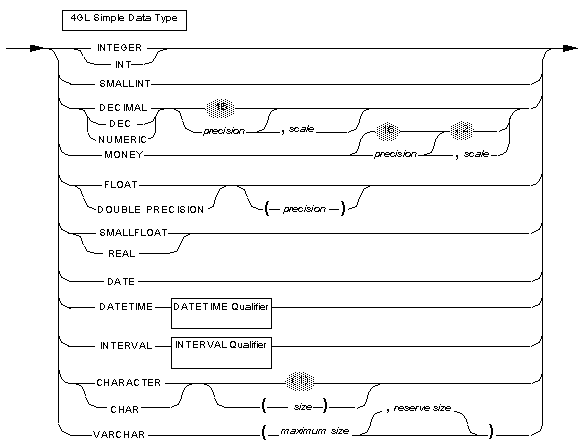 maximum size is a whole number from 1 to 255, specifying the largest number of characters
that a VARCHAR variable can store.
precision specifies the total number of decimal digits, from 1 to 32.
reserve size is a whole number, from 0 to maximum size. The default is 0.
scale is a whole number, from 1 to precision, specifying the number of digits in the
fractional part of a fixed-point number.
size is a whole number from 1 to 32,767, specifying how many characters a CHAR
variable stores. The default is 1.
Each simple data type can be classified as a number, time, or character type:
Number Data Types
4GL supports six simple data types to store various kinds of numbers:
Whole Number Data Types
maximum size is a whole number from 1 to 255, specifying the largest number of characters
that a VARCHAR variable can store.
precision specifies the total number of decimal digits, from 1 to 32.
reserve size is a whole number, from 0 to maximum size. The default is 0.
scale is a whole number, from 1 to precision, specifying the number of digits in the
fractional part of a fixed-point number.
size is a whole number from 1 to 32,767, specifying how many characters a CHAR
variable stores. The default is 1.
Each simple data type can be classified as a number, time, or character type:
Number Data Types
4GL supports six simple data types to store various kinds of numbers:
Whole Number Data Types
| SMALLINT
| Whole numbers, ranging from -32,767 to +32,767.
|
| INTEGER
| Whole numbers, from -2,147,483,647 to +2,147,483,647.
|
| DECIMAL (p,s)
| Fixed-point numbers, of scale s and precision p.
|
| MONEY
| Currency values, of a definable scale and precision.
|
| DECIMAL (p)
| Floating-point numbers of precision p (or by default, 16).
|
| FLOAT
| Floating-point, double-precision numbers.
|
| SMALLFLOAT
| Floating-point, single-precision numbers.
|